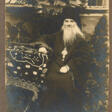Phototype

Phototype
Phototype was a groundbreaking 19th-century printmaking process used primarily for reproducing images and artworks. Developed in France, this technique revolutionized how art was reproduced and made widely accessible.
The phototype process involved transferring a photographic image onto a surface, typically a metal plate, which was then used to produce prints. This method preserved intricate details and tonal variations, making it highly valued for reproducing fine art and photographs. Due to its precision and quality, phototypes were often used to create art prints that closely resembled original paintings and drawings.
Prominent artists and publishers utilized phototype for art books and collections, some of which are displayed in renowned museums and galleries today. The technique played a crucial role in art history, bridging the gap between traditional printmaking and modern photographic reproduction.
For collectors and experts in art and antiques, understanding the phototype process and its historical significance is essential. To stay updated on new product sales and auction events related to phototypes, sign up for our updates.
| Country: | Europe, France |
|---|---|
| Start of the period: | 1855 |

